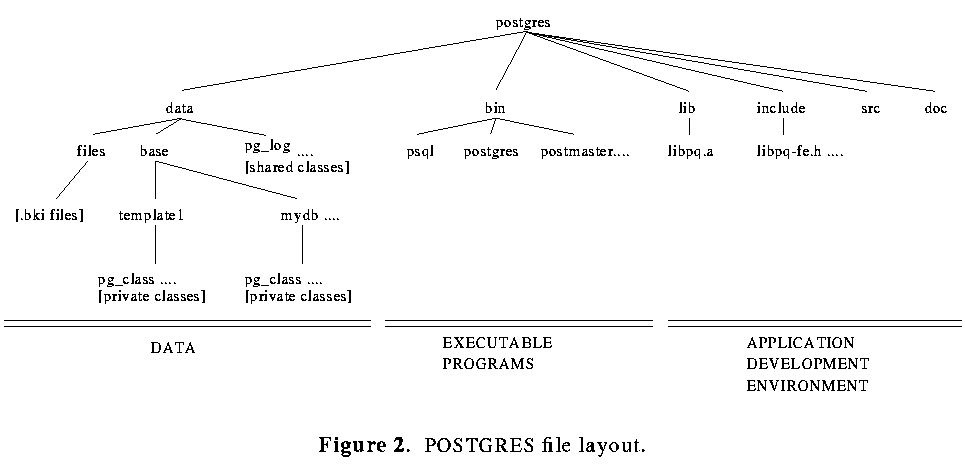Some of the steps listed in this section will apply to all POSTGRES users, and some will apply primarily to the site database administrator. This site administrator is the person who installed the software, created the database directories and started the postmaster process. This person does not have to be the UNIX superuser, "root," or the computer system administrator. In this section, items for end users are labelled "User" and items intended for the site administrator are labelled "Admin." Throughout this manual, any examples that begin with the character ``%'' are commands that should be typed at the UNIX shell prompt. Examples that begin with the character ``*'' are commands in the POSTGRES query language, POSTGRES SQL.
 Figure 2. shows how the POSTGRES distribution is laid
out when installed in the default way. For simplicity,
we will assume that POSTGRES has been installed in the
directory /usr/local/postgres95. Therefore, wherever
you see the directory /usr/local/postgres95 you should
substitute the name of the directory where POSTGRES is
actually installed.
All POSTGRES commands are installed in the directory
/usr/local/postgres95/bin. Therefore, you should add
this directory to your shell command path. If you use
a variant of the Berkeley C shell, such as csh or tcsh,
you would add
Figure 2. shows how the POSTGRES distribution is laid
out when installed in the default way. For simplicity,
we will assume that POSTGRES has been installed in the
directory /usr/local/postgres95. Therefore, wherever
you see the directory /usr/local/postgres95 you should
substitute the name of the directory where POSTGRES is
actually installed.
All POSTGRES commands are installed in the directory
/usr/local/postgres95/bin. Therefore, you should add
this directory to your shell command path. If you use
a variant of the Berkeley C shell, such as csh or tcsh,
you would add
% set path = ( /usr/local/postgres95/bin $path )in the .login file in your home directory. If you use a variant of the Bourne shell, such as sh, ksh, or bash, then you would add
% PATH=/usr/local/postgres95/bin:$PATH
% export PATH
to the .profile file in your home directory.
From now on, we will assume that you have added the
POSTGRES bin directory to your path. In addition, we
will make frequent reference to "setting a shell
variable" or "setting an environment variable" throughout
this document. If you did not fully understand the
last paragraph on modifying your search path, you
should consult the UNIX manual pages that describe your
shell before going any further.
% postmaster &The postmaster occasionally prints out messages which are often helpful during troubleshooting. If you wish to view debugging messages from the postmaster, you can start it with the -d option and redirect the output to the log file:
% postmaster -d >& pm.log &If you do not wish to see these messages, you can type
% postmaster -Sand the postmaster will be "S"ilent. Notice that there is no ampersand ("&") at the end of the last example.
connectDB() failed: Is the postmaster running at 'localhost' on port '4322'?it is usually because (1) the postmaster is not running, or (2) you are attempting to connect to the wrong server host. If you get the following error message:
FATAL 1:Feb 17 23:19:55:process userid (2360) !=
database owner (268)
it means that the site administrator started the postmaster as the wrong user. Tell him to restart it as
the POSTGRES superuser.
% createdb mydbPOSTGRES allows you to create any number of databases at a given site and you automatically become the database administrator of the database you just created. Database names must have an alphabetic first character and are limited to 16 characters in length. Not every user has authorization to become a database administrator. If POSTGRES refuses to create databases for you, then the site administrator needs to grant you permission to create databases. Consult your site administrator if this occurs.
% psql mydbYou will be greeted with the following message:
Welcome to the POSTGRES95 interactive sql monitor:
type \? for help on slash commands
type \q to quit
type \g or terminate with semicolon to execute query
You are currently connected to the database: mydb
mydb=>
This prompt indicates that the terminal monitor is listening to you and that you can type SQL queries into a
workspace maintained by the terminal monitor.
The psql program responds to escape codes that begin
with the backslash character, "\". For example, you
can get help on the syntax of various POSTGRES SQL commands by typing:
mydb=> \hOnce you have finished entering your queries into the workspace, you can pass the contents of the workspace to the POSTGRES server by typing:
mydb=> \gThis tells the server to process the query. If you terminate your query with a semicolon, the \g is not necessary. psql will automatically process semicolon terminated queries. To read queries from a file, say myFile, instead of entering them interactively, type:
mydb=> \i fileNameTo get out of psql and return to UNIX, type
mydb=> \qand psql will quit and return you to your command shell. (For more escape codes, type \h at the monitor prompt.) White space (i.e., spaces, tabs and newlines) may be used freely in SQL queries. Comments are denoted by --. Everything after the dashes up to the end of the line is ignored.
% destroydb mydbThis action physically removes all of the UNIX files associated with the database and cannot be undone, so this should only be done with a great deal of fore-thought.